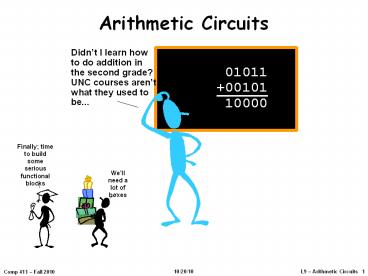Arithmetic Circuits PowerPoint PPT Presentation
Title: Arithmetic Circuits
1
Arithmetic Circuits
Didnt I learn how to do addition in the second
grade? UNC courses arent what they used to be...
010110010110000
Finally time to build some serious functional
blocks
Well need a lot of boxes
2
Review 2s Complement
N bits
20
21
22
23
2N-2
-2N-1
Range 2N-1 to 2N-1 1
sign bit
binary point
8-bit 2s complement example 11010110 27
26 24 22 21 128 64 16 4 2
42 If we use a twos-complement representation
for signed integers, the same binary addition
procedure will work for adding both signed and
unsigned numbers. By moving the implicit
binary point, we can represent fractions too
1101.0110 23 22 20 2-2 2-3 8 4
1 0.25 0.125 2.625
3
Binary Addition
Heres an example of binary addition as one might
do it by hand
A 1101B 010110010
4
Designing a Full Adder From Last Lecture
- Start with a truth table
- Write down eqns for the1 outputsCo CiAB
CiAB CiAB CiABS CiAB CiAB CiAB CiAB - Simplifying a bit (seems hard, but experienced
designers are good at this art!)Co Ci(A B)
ABS Ci ? A ? B
Co Ci(A ? B) AB S Ci ? (A ? B)
5
For Those Who Prefer Logic Diagrams
- A little tricky, but only 5 gates/bit
Co Ci(A ? B) AB S Ci ? (A ? B)
6
Subtraction A-B A (-B)
Using 2s complement representation B B 1
7
Condition Codes
Besides the sum, one often wants four other bits
of information from an arithmetic unit
To compare A and B, perform AB and
use condition codes Signed comparison LT N?V
LE Z(N?V) EQ Z NE Z GE (N?V)
GT (Z(N?V)) Unsigned comparison LTU C
LEU CZ GEU C GTU (CZ)
Z (zero) result is 0 big NOR
gate
N (negative) result is lt 0 SN-1
C (carry) indicates that add in the most
significant position produced a carry, e.g., 1
(-1) from
last FA
V (overflow) indicates that the answer has too
many bits to be represented correctly by the
result width, e.g., (2i-1 - 1) (2i-1- 1)
8
TPD of Ripple-Carry Adder
What is TPD?? See Lec. 8-9.
An-1 Bn-1 An-2 Bn-2 A2
B2 A1 B1 A0 B0
C
Sn-1 Sn-2
S2 S1 S0
Worse-case path carry propagation from LSB to
MSB, e.g., when adding 11111 to 00001. tPD
(tPD,XOR tPD,AND tPD,OR) (N-2)(tPD,OR
tPD,AND) tPD,XOR ? ?(N)
CI to CO
CIN-1 to SN-1
A,B to CO
?(N) is read order N and tells us that the
latency of our adder grows in
proportion to the number of bits in the operands.
9
Can we add faster?
- Yes, there are many sophisticated designs that
are faster - Carry-Lookahead Adders (CLA)
- Carry-Skip Adders
- Carry-Select Adders
10
Adder Summary
- Adding is not only common, but it is also tends
to be one of the most time-critical of
operations. As a result, a wide range of adder
architectures have been developed that allow a
designer to tradeoff complexity (in terms of the
number of gates) for performance.
Smaller / Slower
Bigger / Faster
RippleCarry
Carry Skip
Carry Select
Carry Lookahead
At this point well define a high-level
functional unit for an adder, and specify the
details of the implementation as necessary.
sub
11
Shifting Logic
- Shifting is a common operation that is applied to
groups of bits. Shifting can be used for
alignment, as well as for arithmetic operations. - X ltlt 1 is often the same as 2X
- X gtgt 1 can be the same as X/2
- For example
- X 2010 000101002
Left Shift (X ltlt 1) 001010002 4010
Right Shift (X gtgt 1) 000010102 1010
Signed or Arithmetic Right Shift (-X gtgtgt
1) (111011002 gtgtgt 1) 111101102 -1010
12
Boolean Operations
- It will also be useful to perform logical
operations on groups of bits. Which ones?
ANDing is useful for masking off groups of
bits. ex. 10101110 00001111 00001110
(mask selects last 4 bits)
ANDing is also useful for clearing groups of
bits. ex. 10101110 00001111 00001110
(0s clear first 4 bits)
ORing is useful for setting groups of bits.
ex. 10101110 00001111 10101111 (1s set
last 4 bits)
XORing is useful for complementing groups of
bits. ex. 10101110 00001111 10100001
(1s complement last 4 bits)
NORing is useful for.. uhm ex. 10101110
00001111 01010000 (0s complement, 1s clear)
13
Boolean Unit
- It is simple to build up a Boolean unit using
primitive gates and a mux to select the function. - Since there is no interconnectionbetween bits,
this unit canbe simply replicated at
eachposition. The cost is about7 gates per bit.
One for each primitive function,and approx 3
for the 4-input mux. - This is a straightforward, but not too elegant of
a design.
14
An ALU, at Last
- Now were ready for a big one! An Arithmetic
Logic Unit.
Thats a lot of stuff
FlagsV,C
N Flag
Z Flag

